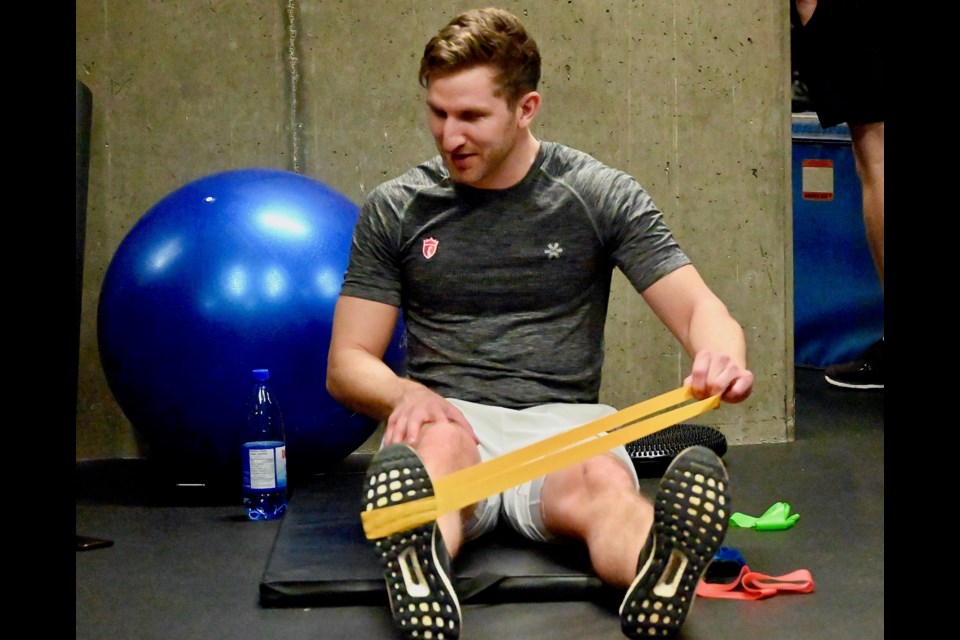Mark Pearson is literally taking it one step at a time towards the curtain call of his decorated field hockey career on the world’s greatest athletic stage this summer.
The 32-year-old from Tsawwassen and national men’s team member is working hard these days to get ready for the 2020 Olympic Games in Tokyo. It will be his third Olympics — having participated in Beijing (2008) and Rio (2016) — as part of 274 international caps to his credit. This time it’s a whole lot more than proving he is a world-class midfielder.
It was about six minutes into the gold medal game against Argentina at the Pan Am Games in Peru last August when Pearson ruptured the achilles tendon in his right leg.
Like most catastrophic sports injuries it was on a routine play with no opponent around him. Pearson would later learn the tendon was vulnerable due to years of overcompensating from a heel condition known as Haglund’s deformity.
“I had received the ball and was cutting in on a defender. As I planted and tried to turn it went,” recalled Pearson, during a national team strength and conditioning session at the Richmond Olympic Oval last month. “You hear stories about it being a loud pop when it happens but mine was more like a shred. I knew what had happened right away. I tried to get up and it was just a floppy foot thing happening. I was actually in no pain.”
Fortunately for Pearson, he had Team Canada’s top medical staff close at hand since it was a multi-sport competition. Among them was New West-based orthopaedic surgeon Dr. Dory Boyer.
He didn’t even go to a hospital in Peru since the team was flying back to Canada the next day.
“Dr. Boyer has operated on more Olympians than anyone in this country. I felt like I was in good hands,” Pearson continued. “He brought me in for screenings and an MRI to further access the damage, then booked me in for surgery about a month after I got back home.”
A ruptured achilles tendon doesn’t always require surgery for a full recovery, however, Dr. Boyer factored in Pearson being a high performance athlete and also used the opportunity to surgically repair his heel as well.
Following the procedure, Pearson relied on family and friends just to live his life as normal as possible. He couldn’t put any weight on his right leg for up to eight weeks and it wasn’t until early January when he could finally drive his car again.
Working with a team of physiotherapists, he is making excellent progress that now includes underwater jogging and jumping. The plan is to be back on the field for a pre-Olympic trip to Japan in late spring.
Look out @De6rasse I'm officially jogging again! #roadtotokyo #achillesrehab pic.twitter.com/u96WS1psJd
— Mark Pearson (@Markajp19) March 1, 2020
“It’s getting my body use to motion again. It isn’t the type of injury where you do four hours of rehab to speed up the process,” said Pearson. “I look around at other athletes for inspiration like (San Francisco 49ers receiver) Emmanuel Sanders who is the same age as me and did in his achilles a year and a half ago. He has come back and not missed a beat.”
Pearson served as a mentor from the sidelines last September when his teammates clinched an Olympic berth with a thrilling come-from-behind victory over Ireland in West Vancouver.
He knows his spot back on the roster is no certainty, depending on how well the rehabilitation process continues over the next three months. However, his experience is a huge asset and he was in outstanding form prior to the injury that included scoring six goals at the Pan Am Games.
“There is a clear end date of May or early June where I need to get back. I need to prove my fitness and I need to prove I can make the team. I’m not going to just walk onto an Olympic team. There are 25 guys here in the gym today and there are 16 (roster) spots,” Pearson added. “Obviously I do have the experience and I was in really good form last year. For me now, it’s just trying to get back to that level.”



